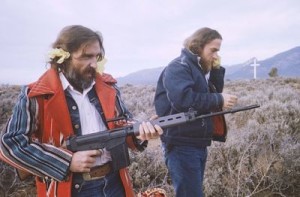STUDIO: Etiquette Pictures | DIRECTORS: Lawrence Schiller and L.M. Kit Carson
RELEASE DATE: 9/22/15 | PRICE: Blu-ray/DVD Combo $32.98
BONUSES: “Fighting Against the Wind” featurette, “A Long Way Home” featurette, gallery of photos by Lawrence Schiller
SPECS: NR | 81 min. | Documentary | 1.33:1 widescreen | mono
After the massive box-office success of Easy Rider, Dennis Hopper was the most sought-after director in Hollywood. Instead of selling out to the mainstream (something he did wholeheartedly in the Nineties). Hopper decided at that point to make the messy, self-reflexive Last Movie, which served to kill his career for the Seventies and half of the Eighties.
As he was editing The Last Movie in Taos, New Mexico, Hopper agreed to let photographer Lawrence Schiller and actor-screenwriter L.M. Kit Carson (David Holzman’s Diary) make The American Dreamer, a free-form, thoroughly entertaining profile, first released in 1971. The film shows him at the peak of his hippie period, when he was eager to assume the role of a charismatic con man.
The “con” here is the documentary mode itself. Schiller notes in a featurette here that the film is decidedly not a documentary and that Hopper isn’t being himself, he’s “an actor playing a role.”
Determining what that role may be is up to the viewer. For the Hopper seen here is a pacifist who loves to shoot guns, an artist who is concerned about the box office and a humble soul who is also a raging egomaniac. He also discusses feminist ideas but never, ever stops thinking about getting laid.
The last-mentioned aspect takes over the film as it moves on, making it a wonderfully revealing portrait of a supposedly “radical” figure whose fixation on sex is resolutely old-fashioned. While the first two-thirds of the picture spotlights Hopper the “thinker” and artist, the last third shows him attempting to charm a roomful of women into sleeping with him (or each other).
The would-be orgy is one of the craziest scenes is a documentary that is already pretty crazy. Schiller and Carson clearly realized that focusing on Hopper’s “cosmic” truths was getting them nowhere. In addition, the much-lauded director of Easy Rider admits on-camera that he finds the editing process extremely boring.
In an attempt to get something intense and “cinematic” to occur, the two directors decided to make Hopper’s ultimate fantasy — “to go for a month with three chicks to the hot springs” — come to life. Thus we are treated to the sight of hippie Dennis in his house with over a dozen women that Schiller notes in the featurette were gotten from the local airport (with the query “how would you like to be a movie with Dennis Hopper?”).
Hopper’s methods of seduction are wonderfully transparent. He tries to get the women to feel comfortable around him, and to take their clothes off. His best approach is to ask them to consider him “just another chick…” and to explain why he considers himself a male lesbian. This theory, expounded earlier in the film, revolves around the fact that he cares more about his partner’s pleasure than his own; it sounds a bit odd when shoehorned between sequences where he refers to women as “broads” and “cooze.”
This leads to him discussing how different segments of society can exploit others (the assumption being that he’s condemning men — “I’ve been fucked over righteously!” he exclaims) and his handy suggestion that a group massage take place (“as long as Dennis is not the person massaged,” Hopper adds with more than an ounce of faked persuasion).
The would-be orgy is quite a show-piece and it solidly situates the film as a product of the era in which American film toyed with narrative experimentation and subversive content (be it legitimately subversive or merely an attempt to seem so). Schiller and Carson “date” the film handily by using editing techniques that Hopper had used in Easy Rider, most notably sudden freeze frames in the midst of an action and flash-forwards to later events. These techniques demonstrated Hopper’s knowledge of the underground film movement of the Sixties.
One of the supplemental featurettes recounts the restoration process that led to this deluxe Blu-ray/DVD package, which is the first-ever home-entertainment release of the film. A print essay by Chris Poggiali in the accompanying booklet explore the reasons why the film was “lost” for so long — made to be shown exclusively to college audiences, the film was pulled from distribution by Universal Pictures when it was shown in local movie theaters by college film groups.
The other, longer featurette examines both American Dreamer and Last Movie in depth, with Schiller and others discussing how Hopper conceived of the former as a publicity piece for the latter. Schiller admits that Dreamer isn’t what he’d hoped it would be. The naïveté that he attributes to Carson and himself, though, is the reason the film is so watchable — more seasoned documentarians would’ve shut Hopper’s pretensions down and thus lost the most entertaining material in the picture.
It should be noted in closing that no one in the featurette refers to the invaluable time-capsule aspect of the picture. As well as the fact that it could serve as an object lesson to directors whose first films are massive hits and whose sophomore efforts are more personal, indulgent works.
|
Buy or Rent The American Dreamer
|
|||
|---|---|---|---|
 |
|||

Leave a Reply